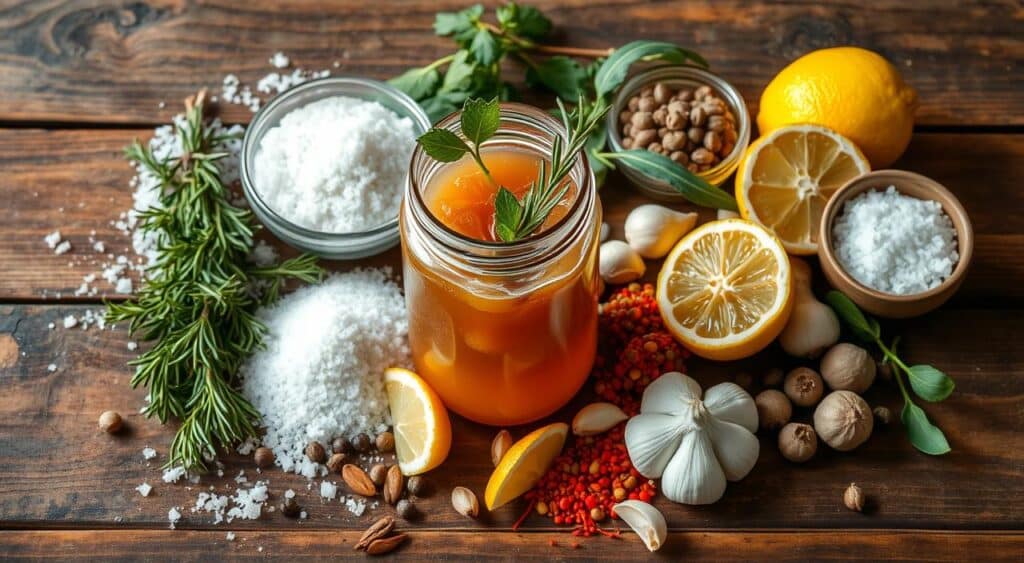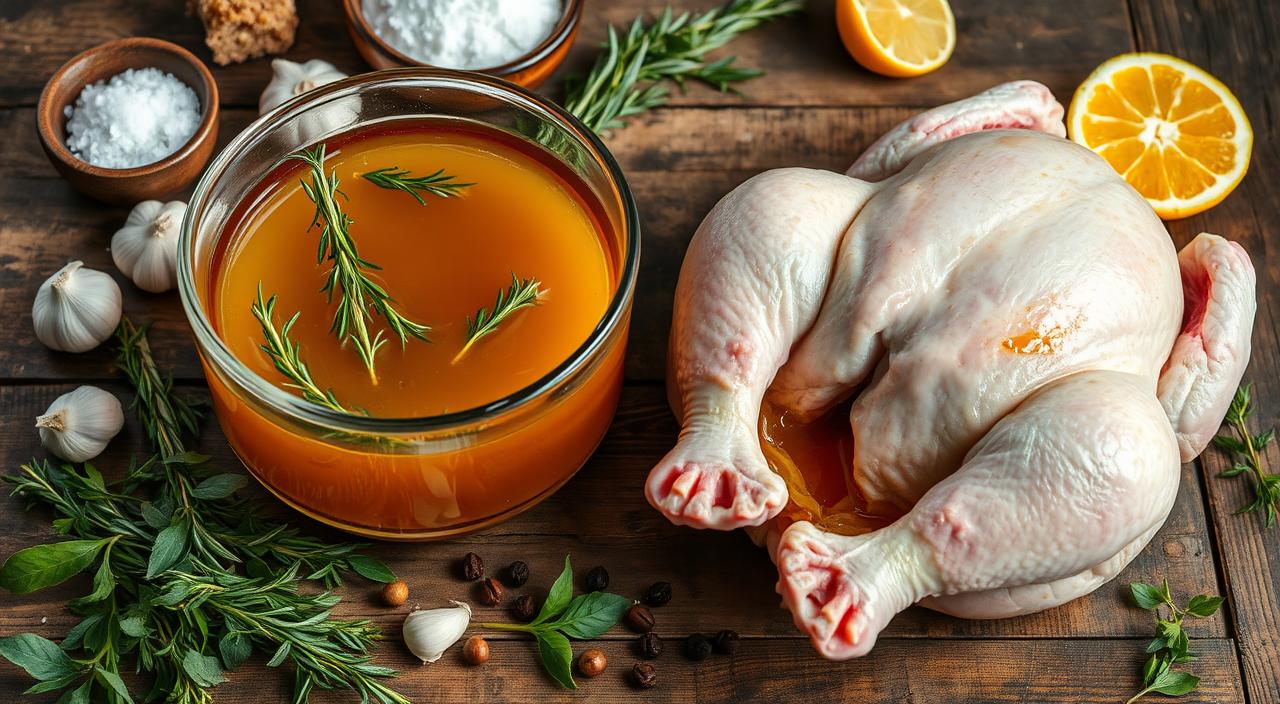Jump to:
Are you tired of dry, bland chicken? The best chicken brine recipe is here to help. It’s adapted from Thomas Keller, a culinary master. This brine makes your roast chicken juicy, flavorful, and tender.
Brining involves soaking chicken in a salt-based liquid, called a brine. This process adds flavor, tenderizes the meat, and keeps it moist. Sydney’s Glebe Point Diner, Boronia Kitchen, and Restaurant Hubert use this method. Now, you can too.
The secret to this amazing brine recipe is in its ingredients. You’ll need water, salt, and optional extras like honey, herbs, garlic, and lemon. Marinating the chicken in this brine for 12 to 24 hours makes it tender, juicy, and full of flavor.
Key Takeaways
- Brining chicken is the secret to achieving juicy, flavorful results.
- This brine recipe is adapted from renowned chef Thomas Keller.
- The brine includes essential ingredients like water and salt, with optional flavorings.
- Brining time is recommended between 12 to 24 hours in the fridge.
- Brined chicken cooks faster and retains moisture better than unbrined chicken.
Introduction
Creating the perfect chicken brine recipe is key to juicy, flavorful chicken. Whether you roast, grill, or fry, the right chicken marinade makes all the difference. This guide will cover the science of brining, essential ingredients, and a step-by-step for the best chicken brine recipe. Get ready to enjoy the most tender poultry brine ever!
| Brine Time | Active Prep Time | Brine Ingredients | Chicken Size |
|---|---|---|---|
| 8 to 24 hours | 10 minutes | Honey, coarse sea salt, garlic, herbs, peppercorns, lemon | 4-5 lbs whole chicken |
The secret to brining chicken is understanding the science. Submerging chicken in a saltwater solution makes it juicy and flavorful. Whether it’s for a holiday or a weeknight dinner, mastering the chicken brine recipe changes how you cook poultry.

“Brining is the secret to the most tender, juicy, and flavorful chicken you’ll ever taste. It’s a simple trick that takes your poultry to the next level.”
Why You Need the Best Chicken Brine Recipe
Preparing juicy and flavorful chicken is easier with a chicken brine recipe. Chefs and restaurants use brining to add flavor and keep the meat moist. This method makes the chicken tender and juicy, even when it’s perfectly cooked.
The Science Behind Brining
Brining is simple. Submerging chicken in saltwater starts osmosis. The salt goes into the meat, making it juicy and tender.
How Brining Enhances Flavor and Moisture
The brine also brings flavors into the chicken. Adding garlic, herbs, and spices to the brine makes the meat taste amazing. Every bite is full of flavor.
Benefits of Brining Chicken Over Other Methods
- Ensures juicy, tender, and flavorful chicken, even when overcooked
- Allows for greater control over seasoning and flavor throughout the entire cut of meat
- Provides a safety net against drying out the chicken during cooking
- Offers a more consistent and reliable way to achieve moist, delicious chicken every time
The best chicken brine recipe is essential for anyone who wants to improve their chicken dishes. It adds flavor and juiciness.

Essential Ingredients for the Best Chicken Brine Recipe
To make the perfect chicken brine, you need to know the key ingredients. Water and salt are the basics that make chicken juicy and flavorful. You can also add herbs, spices, and other ingredients to make the brine even better.
Key Components: Salt, Water, and Flavorings
The heart of a good chicken brine is water and salt. Use 2 cups of water and 1/3 cup of kosher salt. This mix helps tenderize and season the chicken well. Kosher salt works best because its big crystals help the brine soak into the meat.
Optional Ingredients to Elevate the Flavor
- Citrus: Lemon, lime, or orange slices add a refreshing, bright note to the brine.
- Herbs: Fresh sprigs of thyme, rosemary, parsley, or a blend of your favorite herbs can infuse the chicken with earthy, aromatic flavors.
- Aromatics: Garlic cloves, peppercorns, and bay leaves lend depth and complexity to the brine.
- Sweeteners: A touch of honey or maple syrup can balance the saltiness and create a delightful sweet-savory profile.
How to Choose Herbs and Spices for Your Brine
When picking herbs and spices, think about what goes well with chicken. Thyme, rosemary, and garlic are great choices. But don’t be afraid to try new things. The goal is to find a mix that makes the chicken taste amazing without being too strong.
| Ingredient | Amount |
|---|---|
| Water | 2 cups |
| Kosher salt | 1/3 cup |
| Lemon slices | 2 |
| Garlic cloves | 4 |
| Fresh thyme sprigs | 3 |
| Peppercorns | 1 tablespoon |
| Bay leaves | 2 |
| Honey | 2 tablespoons |

Step-by-Step Guide to Making the Best Chicken Brine Recipe
Making the perfect chicken brine recipe is key to juicy, flavorful chicken. It’s a simple process, but each step is important. Let’s explore how to make the ultimate chicken brine.
Step 1: Preparing the Brine Solution
Start by mixing water, salt, and flavorings like herbs, spices, or citrus in a pot. Bring it to a boil to dissolve the salt and release flavors. After boiling, remove it from heat and add cold water to cool it down. Refrigerate the brine until it’s cold before moving on.
Step 2: Brining the Chicken Properly
- Put the chicken in the chilled brine, making sure it’s fully covered. Place the chicken upside down for even flavor distribution.
- Put a cover on the container and refrigerate the chicken for 12 to 24 hours. Brining for 18-24 hours gives the best flavor and tenderness.
Step 3: How Long to Brine for Optimal Results
The best brining time for chicken is 1 hour per pound. But for the best taste and texture, brine for up to 24 hours. Don’t brine too long, as it can make the chicken mushy. After brining, pat the chicken dry and cook it as you like, whether roasting, grilling, or frying.
“A good ratio for basic brine is 4 tablespoons of salt for each quart of water. A quart of brine is enough for about 1 1/2 pounds of chicken.”
Variations of the Best Chicken Brine Recipe
The basic chicken brine recipe is tasty, but you can also try different flavors. A citrus-infused brine for chicken with lemon or orange slices adds a refreshing twist. An herbaceous poultry brine made with extra rosemary, thyme, and parsley creates a deeper, more savory flavor. For a sweet and savory brine variations, try adding honey or maple syrup along with the other aromatics.
Citrus-Infused Brine for a Fresh Twist
To create a citrus-infused chicken brine recipe, add thin slices of lemon or orange to your basic brine solution. The bright, zesty notes of citrus will complement the saltiness of the brine. This will infuse your chicken with a refreshing, summery flavor.
Herbaceous Brine for a Deeper Flavor
For a more aromatic and savory brine for chicken, add lots of fresh herbs like rosemary, thyme, and parsley. The herbaceous notes will permeate the meat. This creates a depth of flavor that pairs beautifully with roasted or grilled chicken.
Sweet and Savory Brine with Honey or Maple
To strike a balance between sweet and savory, add a touch of honey or maple syrup to your poultry brine recipe. The natural sweetness will counteract the saltiness. This results in a well-rounded flavor profile that is sure to delight your taste buds.
| Brine Variation | Key Ingredients | Flavor Profile |
|---|---|---|
| Citrus-Infused | Lemon or orange slices | Bright, zesty, refreshing |
| Herbaceous | Rosemary, thyme, parsley | Aromatic, savory, depth of flavor |
| Sweet and Savory | Honey or maple syrup | Balanced, sweet and salty |
These brine variations for chicken offer a range of flavors to suit your taste. Experiment with different combinations. Find the one that best complements your favorite chicken dishes.
Common Mistakes to Avoid When Brining Chicken
Brining chicken in a saltwater solution can make it moist, tender, and flavorful. But, there are a few mistakes to avoid for the best results. Check out these tips to brine chicken right.
Over-Brining and Its Impact on Texture
One big mistake is over-brining the chicken. If you leave it in the brine too long, it can become tough and rubbery. It can also taste too salty. The best brining time varies by chicken size and cut, but usually, it’s 12-24 hours.
Not Rinsing the Chicken After Brining
Another mistake is not rinsing the chicken well after brining. If you don’t rinse off the extra salt, your dish might taste too salty. Make sure to rinse it under cold water and dry it before cooking.
Using Too Much or Too Little Salt
The right amount of salt in the brine is key. Too much salt makes the chicken too salty, while too little doesn’t add enough flavor. Use about 3/4 cup of kosher salt for every 1 gallon of water.
By avoiding these mistakes, you’ll get juicy, flavorful chicken every time. Follow these tips for perfectly seasoned chicken.
How to Store Chicken After Brining
After brining your chicken to perfection, it’s crucial to store it right. This keeps it juicy and flavorful. Whether you’re cooking it immediately or later, follow these tips.
Refrigeration Techniques for Marinated Chicken
First, pat the chicken dry with paper towels after brining. Then, store it in the fridge for 3-4 days before cooking. Use an airtight container or bag to keep it moist.
Can You Freeze Brined Chicken?
Yes, you can freeze brined chicken, but it might change texture a bit. Place it in an airtight container or bag, squeezing out air. It can stay frozen for 3 months. Thaw it in the fridge before cooking.
Best Practices for Storing Leftover Brined Chicken
For leftover brined chicken, refrigerate it and use it in 3-4 days. The brine can be reused for 3 days if kept cold. This is a smart way to store brined chicken and refrigerate brined chicken.
“Proper storage is key to maintaining the juiciness and flavor of your brined chicken. By following these guidelines, you can enjoy the benefits of brining long after the initial preparation.”
Cooking Methods for Brined Chicken
Brined chicken is great for many cooking methods. It can be roasted for crispy skin or grilled for smoky flavor. Each method brings out the best in your brined bird.
Roasting Brined Chicken for Crispy Skin
Roasting brined chicken makes the skin golden and crispy. The brine keeps the meat moist and full of flavor. Just pat it dry, season, and roast at 450°F for 20-25 minutes until it’s 165°F inside.
Grilling Brined Chicken for Smoky Flavor
Grilling brined chicken adds a smoky taste. The brine keeps the meat moist, and the high heat caramelizes the outside. Grill it for 8-10 minutes per side, turning often, until it’s cooked through.
How Brined Chicken Affects Frying and Searing
Brining changes how brined chicken fries or sears. It browns well without drying out. When frying brined chicken, it gets a crispy crust but stays juicy inside. For searing, it develops a tasty crust while staying tender inside.
Brined chicken is a game-changer for poultry dishes. Its seasoning and moisture-locking properties make it juicy, tender, and flavorful every time.
Nutritional Benefits of Brining Chicken
Brining chicken makes it taste better and juicier. It also has great nutritional benefits. By using the right ingredients, you can make a healthy chicken brine recipe. This way, you can enjoy a nutritious meal.
Sodium Content and Managing Salt Levels
Brining can be high in sodium. But, you can control the salt levels. Use a lower-sodium broth or less salt in the brine.
Retaining Moisture Without Adding Extra Fat
Brining keeps chicken moist and juicy without extra fat. It uses the chicken’s natural moisture. This makes brined chicken healthier than other methods.
Using Healthier Brine Ingredients for a Low-Calorie Meal
You can make your brine healthier by choosing better ingredients. Use low-sodium broth, fresh herbs, and citrus fruits. This creates a tasty, low-calorie meal.
| Nutrient | Brined Chicken (3.5 oz) | Unbrined Chicken (3.5 oz) |
|---|---|---|
| Calories | 126 | 165 |
| Carbs | 4g | 0g |
| Sodium | 185mg | 73mg |
Brined chicken is better for you, with fewer calories and less sodium. By learning about the nutritional benefits of brining chicken, you can make healthy meals your family will enjoy.
FAQ: Best Chicken Brine Recipe
Creating the perfect chicken brine recipe can change your cooking game. Whether you’re a pro or just starting, you might have questions. Here, we’ll answer the most common ones to help you get juicy, flavorful chicken every time.
What is the ideal brine ratio for chicken?
The best brine ratio for chicken is 2 quarts of water, ⅓ cup of kosher salt, and ¼ cup of sugar. This mix of salt, water, and a bit of sugar keeps the chicken moist and flavorful.
How long should I brine chicken?
Brine chicken for 8-24 hours for the best results. This time lets the brine deeply penetrate the meat, making it tender and juicy. But, don’t brine too long, or it might become mushy.
Can I add additional ingredients to the brine?
- Absolutely! Herbs like thyme, parsley, and bay leaves add great flavor.
- Garlic, peppercorns, and citrus slices can also enhance the taste.
- Feel free to experiment to find your favorite flavors.
How do I properly dry the chicken after brining?
After brining, dry the chicken well with paper towels. This step is key to getting crispy skin when you roast, grill, or fry it.
| Nutrition Facts (per serving) | Value |
|---|---|
| Calories | 30kcal |
| Carbohydrates | 8g |
| Protein | 1g |
| Fat | 1g (saturated, polyunsaturated, and monounsaturated) |
| Sodium | 4728mg |
| Sugar | 6g |
| Vitamins | A, C |
| Minerals | Calcium, Iron |
The chicken brine recipe FAQ is here to help you make the best brined chicken. Knowing the right ratios, brining times, and how to add flavor will help you master the art of chicken brine questions.
“Brining chicken adds moisture and flavor, denaturing the proteins to make the meat tender and juicy.”
Conclusion: Perfecting Your Chicken with the Best Chicken Brine Recipe
Brining is the secret to the most succulent, tender chicken you’ll ever make. By following this easy-to-make chicken brine recipe, you’ll achieve perfectly seasoned, juicy poultry every time. Whether you’re roasting, grilling, or frying chicken, this brining method will ensure moist, flavorful results that will impress your family and friends.
The key to the best chicken brine recipe lies in the perfect balance of salt, sugar, and flavorful ingredients. By soaking your chicken in this brine, you’ll lock in moisture and infuse the meat with a delightful blend of seasonings. The result is a juicy, tender chicken that’s bursting with flavor in every bite.
Mastering the art of brining takes a bit of practice, but once you’ve got the technique down, you’ll never go back to unbrined chicken. From perfectly cooked chicken breasts to a mouthwatering roast chicken, this brine recipe is a game-changer. Elevate your chicken dishes to new heights and impress your guests with the best chicken brine recipe.
FAQ
What is the purpose of brining chicken?
Brining chicken makes it taste better and keeps it juicy. It involves soaking the chicken in a saltwater mix. This mix seasons the meat and makes it tender and moist.
What are the essential ingredients for a chicken brine?
You need water and salt for a chicken brine. Salt is key for flavor and tenderness. You can add herbs, spices, citrus, and sweeteners to customize the taste.
How long should I brine chicken?
Brine chicken for 12-24 hours for the best results. Soaking it for 18-24 hours makes it very flavorful and tender. But, don’t brine it too long to avoid toughness and saltiness.
Can I reuse the chicken brine?
Yes, you can reuse chicken brine for up to 3 days in the fridge. Just strain it before using again. But, don’t reuse it forever as the flavor will fade.
How do I store brined chicken?
Pat dry the brined chicken and refrigerate it for 3-4 days before cooking. You can also freeze it, but the texture might change. Always refrigerate leftovers and use them within 3-4 days.
Can I brine chicken and then cook it in different ways?
Yes, you can cook brined chicken in many ways. Roasting makes the skin crispy and the meat juicy. Grilling adds a smoky taste. It also browns well when fried or seared.
Is brining chicken a healthy cooking method?
Brining chicken can be healthier because it keeps moisture without extra fat. Use the right salt amount and rinse well. You can also use low-sodium broth and fresh herbs for a healthier dish.






